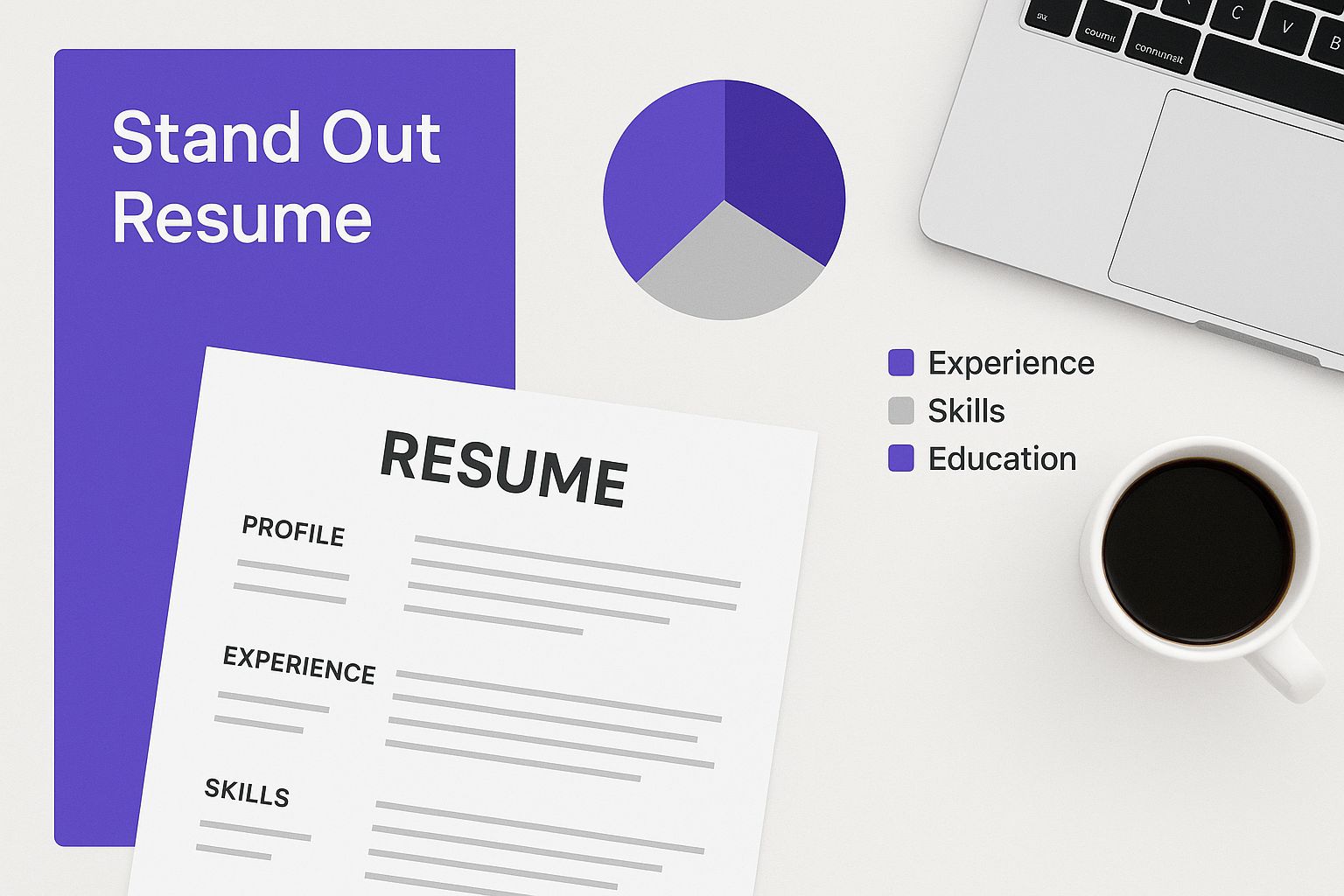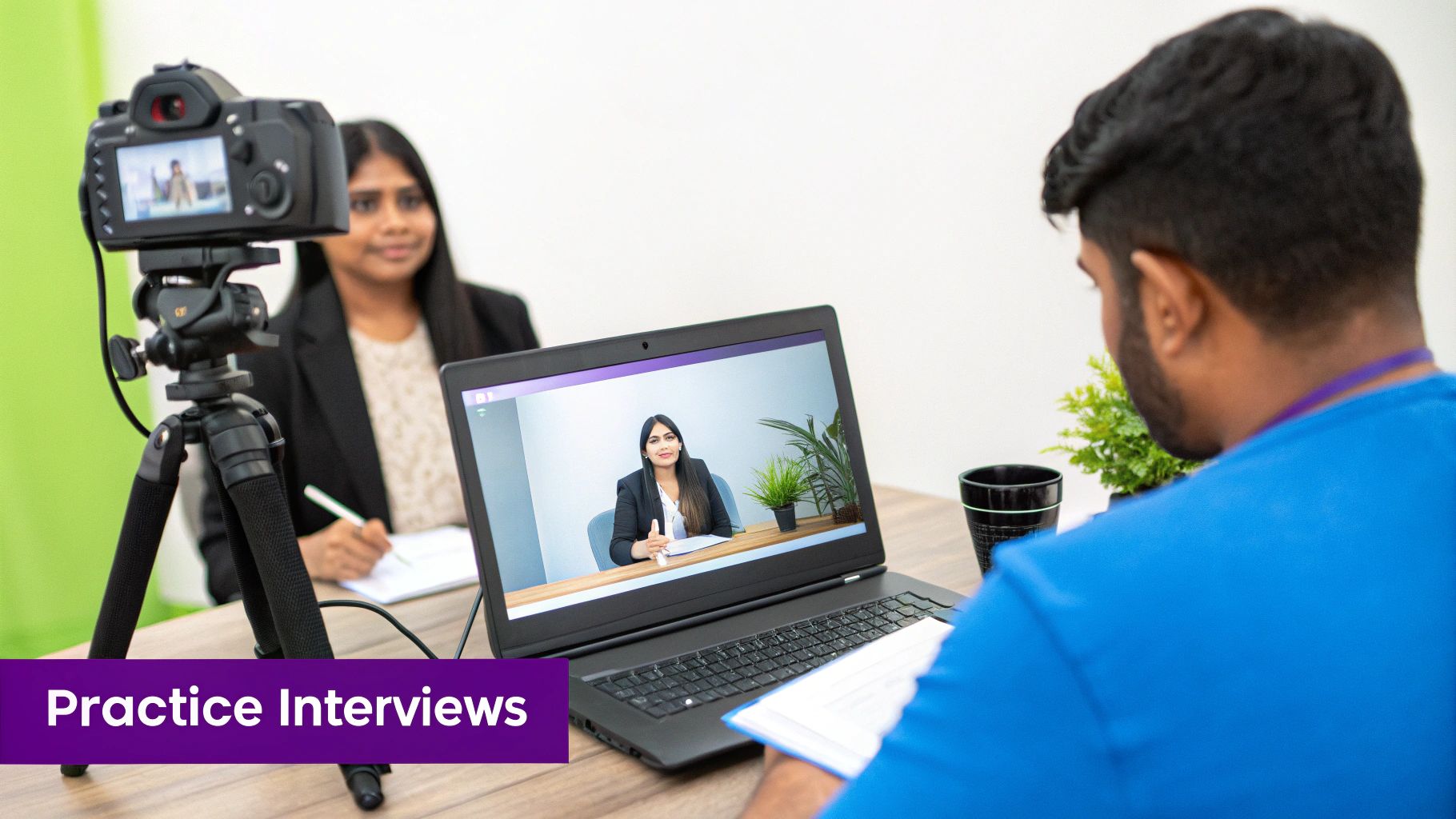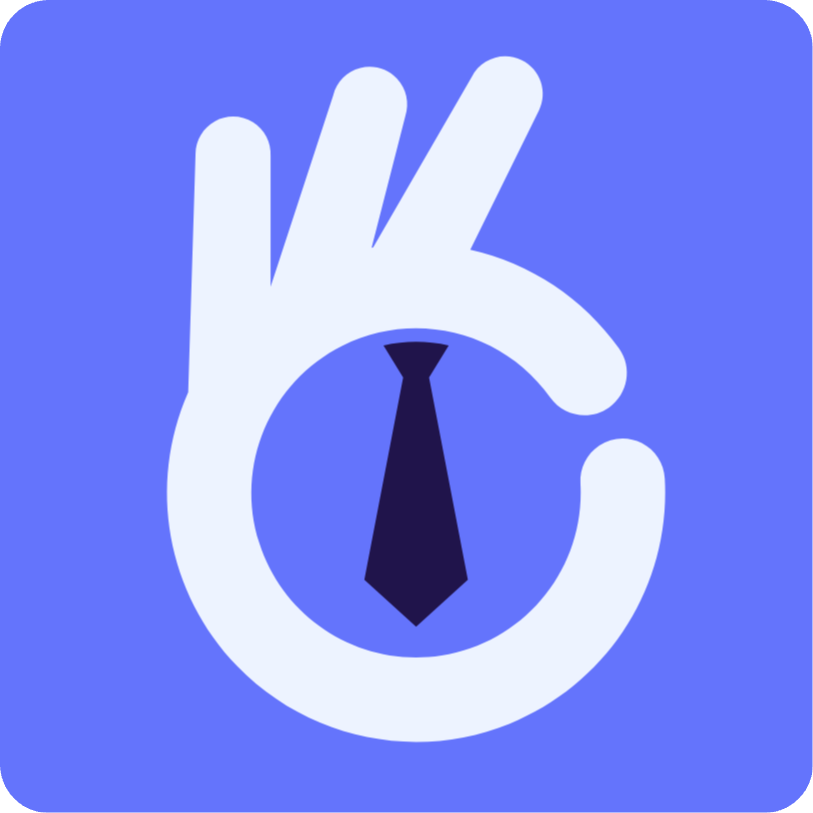How to Get More Job Interviews: Proven Strategies to Land Answers
That sinking feeling when you've sent out dozens of applications, only to be met with a silent inbox? It's demoralizing, and I've been there. The tough pill to swallow is that the modern job market is a numbers game, and the odds are stacked against you from the start.
But here's the good news: understanding why your applications are getting lost in the shuffle is the first step to fixing the problem and finally getting the calls you deserve.
Why Your Applications Are Getting Ignored
If you feel like your resume is disappearing into a black hole, you’re not wrong. For every single job posting, an average of 118 candidates throw their hat in the ring. Out of those, only about 20% actually land an interview.
Let that sink in. For every 100 people who apply, roughly 80 are filtered out before ever speaking to a real person. You can see more on how these numbers break down by checking out these job interview statistics.
This isn’t meant to discourage you—it's meant to be a wake-up call. The old "spray and pray" method of blasting a generic resume everywhere just doesn't cut it anymore. You're not just up against other job seekers; you're battling sophisticated Applicant Tracking Systems (ATS) and recruiters who spend mere seconds glancing at each resume.
The Brutal Reality of the Job Funnel
To really get a handle on the challenge, you need to visualize the job application funnel. It’s a ruthless process of elimination where the pool of candidates gets smaller and smaller at each stage.
Seeing the numbers laid out makes it crystal clear why a targeted, strategic approach isn't just a good idea—it's essential.
The single biggest mistake I see job seekers make is underestimating the competition and the role of automated filters. A successful job search isn't about applying more; it's about applying smarter to beat the odds at every stage.
To help you see just how steep the drop-off is, I’ve put together a quick table that shows the journey of 100 applications.
The Job Application Funnel At a Glance
| Stage | Average Applicants Reaching This Stage (per 100) | Key Takeaway |
|---|---|---|
| Initial Application | 100 | The starting pool is large and diverse. |
| ATS & Recruiter Screen | 20-25 | Most are eliminated by software or a quick scan. |
| Hiring Manager Review | 4-6 | Only the most relevant candidates get a closer look. |
| First Interview | 2-3 | The field has narrowed dramatically. |
| Final Interview | 1 | Typically, only the top contender remains. |
The numbers don’t lie. The funnel is steep, and the competition is fierce. Your primary goal is to survive that first massive cut.
This infographic really drives home how a standout resume can get you past that initial screening.

Think of your resume as your ticket past the gatekeepers. It’s the foundation for everything else. Without a document that is both optimized for the ATS and compelling to a human reader, your chances of getting an interview plummet. This is a core concept for anyone serious about getting hired faster in today's market. Every detail, from the keywords you choose to how you frame your wins, truly matters.
Craft a Resume That Beats the Robots
Before your resume ever lands in a hiring manager's hands, it has to get past the gatekeeper: the Applicant Tracking System (ATS). Think of it as a bouncer for your resume. These systems scan every single application, looking for specific keywords and formatting. Only after you pass this first robotic test does a human see what you've got—and even then, they'll probably only give it a few seconds.
The numbers are pretty brutal. In most industries, only about 2% of applicants actually get an interview. For every open position, a company might only interview six people. That’s not a lot of room for error. It means your resume has to be sharp enough for the software and compelling enough for a person.
Your secret weapon here is the job description. Don't just skim it—treat it like a cheat sheet.
Decode the Job Description for Keywords
Ignoring the exact language in the job posting is the fastest way to get your resume tossed in the digital trash bin. The ATS is literally programmed to find the keywords and phrases pulled straight from that description. Your first mission is to hunt them down.
- Skills and Tech: Look for the specific tools they mention, like Salesforce, Python, or the Adobe Creative Suite. Note any methodologies too, such as Agile or SCRUM.
- Actions and Duties: What verbs do they use? Pay attention to words like "managed," "developed," "analyzed," or "optimized."
- Culture and Soft Skills: Don't forget the softer stuff. Look for clues about their culture, like "collaborative," "fast-paced environment," or "proactive."
Once you have your list, you need to weave these exact terms into your resume. Sprinkle them into your professional summary, your work experience bullet points, and your skills section. It needs to feel natural, not just stuffed in.
A great way to see if you've hit the mark is to run your resume through a tool that gives you an ATS score. If you want to dive deeper, check out our guide on how a resume ATS checker works.
From Duties to Achievements
Okay, so you made it past the robot. Now you have to impress the human. Recruiters and hiring managers don't just want a list of your old job duties. They want to see what you actually accomplished. They're looking for results.
"A common mistake is simply listing job duties. Instead, focus on the impact you made. Recruiters want to see numbers—how you saved money, increased efficiency, or grew revenue. That’s what gets you an interview."
Let’s see what this looks like in practice.
Before (Duty-Focused):
- Managed social media accounts for the company.
- Wrote blog posts and created content.
- Responsible for email marketing campaigns.
After (Achievement-Focused):
- Grew social media engagement by 45% across three platforms by implementing a new content strategy.
- Increased organic blog traffic by 200% in six months, leading to a 15% rise in qualified leads.
- Managed email campaigns that generated $50,000 in Q4 revenue with an average open rate of 32%.
See the difference? It's a game-changer. Shifting from "what I did" to "what I achieved" is how you stand out. If you're using AI to help brainstorm these points, just make sure your real voice comes through. It’s important to humanize your AI-generated content to pass detection so your accomplishments feel authentic and impressive.
Turn Your LinkedIn Into an Opportunity Magnet

Think of your LinkedIn profile. Is it just a digital version of your resume, sitting there collecting virtual dust? If so, you're missing out. To get more interviews, your profile needs to stop being a passive document and start acting like a magnet for recruiters. It's about making opportunities come to you.
It all starts with getting found. Recruiters live inside LinkedIn's search filters, and if your profile isn't loaded with the right keywords for the jobs you want, you’re basically invisible.
This is more than just listing old jobs. It's about consciously building a professional story that grabs the attention of the right people.
Make Your Profile Recruiter-Friendly
Your headline is the most valuable piece of real estate on your entire profile. Don't just put your current title. Pack it with keywords that scream "this is what I do" and "this is the job I want next."
- A weak headline looks like this: "Marketing Manager at ABC Company"
- A strong headline looks like this: "Marketing Manager | Digital Strategy | SEO & SEM | Content Marketing | B2B SaaS"
See the difference? One is a label, the other is a billboard for your skills.
Next up is your "About" summary. This isn't the place to just rehash your work history. Tell a story. What kind of problems do you love to solve? What makes you tick professionally? Weave in the skills and experiences that you know hiring managers in your target field are looking for.
And don't forget the "Featured" section! This is your chance to show, not just tell. Link to your portfolio, articles you've published, or projects you’re proud of. It’s instant credibility.
Engage to Build Credibility
Having a great profile gets you found, but engagement is what gets you noticed. A quiet profile won’t spark any conversations. You have to get in the game and participate.
The goal isn't just to be seen, but to be seen as a credible, knowledgeable professional. Sharing a relevant article is good; adding a thoughtful comment explaining why it's important is better. This simple act builds authority.
Jump into industry groups and follow the people who are shaping the conversation. But don't just be a lurker—add to the discussion.
- Share valuable content: Find articles or studies relevant to your field. When you post, add your own two cents on why it's a big deal.
- Write insightful comments: When someone in your network posts something interesting, drop a comment that builds on their point or asks a smart question. It’s way more powerful than a generic "great post!"
- Connect with purpose: Never send a blank connection request, especially to recruiters or people at companies you're targeting. Always add a short, personalized note.
By actively engaging, you send a clear signal to recruiters: you're passionate, you're current, and you're invested in your field. For more specific strategies, especially if you're targeting remote work, dive into optimizing your LinkedIn profile for remote roles. This proactive approach is how you turn a simple profile into a machine for generating interview requests.
Adopt a Quality Over Quantity Application Strategy
It’s tempting, I know. Firing off a hundred generic applications in a day feels productive. But let's be honest, it's usually just a fast track to a silent inbox and some serious job search burnout. The old "spray and pray" method is like playing the lottery—you're just hoping one of your tickets hits.
It's time to stop playing the odds and start making calculated moves. This means flipping the script and focusing on value over sheer volume.
https://www.youtube.com/embed/8OTxZyR3tBE
A targeted, quality-over-quantity strategy is your best bet for actually landing more interviews. It’s about being intentional. Instead of blasting your resume into the void, you hand-pick opportunities where you know you can make a real impact and solve a company's actual problems. Yes, it takes more work upfront, but the payoff is so much better.
This approach is especially powerful right now. The latest data shows that hiring is a huge headache for companies all over the world, with a staggering 77% of organizations reporting they struggle to fill roles. A big reason for this is a shortage of qualified candidates, which is great news for you. A well-prepared, targeted application immediately sets you apart from the crowd. You can dig into more of these recruitment and training statistics to see the full picture.
Identify and Research Your Target Companies
First things first: stop applying to every "good enough" job that pops up. Instead, build a curated list of companies you'd genuinely be excited to work for. Think about what truly matters to you, beyond just the salary.
- Company Culture: Are you built for the hustle of a fast-paced startup, or do you prefer the stability of a more structured corporate world? Check out their careers page, see what they post on social media, and read employee reviews on sites like Glassdoor.
- Mission and Values: Does the company's "why" resonate with you? Working for a mission you actually believe in is a game-changer for motivation and fulfillment.
- Growth Opportunities: Look into what happens after you're hired. Does the company have a track record of promoting from within? Do they invest in training and development for their people?
This research isn't just for your own peace of mind—it's powerful ammunition for your application. It lets you speak their language and explain exactly why you're the perfect fit for their specific team and their unique mission.
The goal is to transform yourself from just another applicant into a sought-after candidate. When you apply with genuine, informed interest, it screams that you're serious. You're no longer just asking for a job; you're proposing a partnership.
Decode the Job Description to Find the Problem
Think of every job description as a company's cry for help. They have a pain point, and they think a new hire is the solution. Your job is to become a detective and figure out what that core problem really is. Don't just scan for keywords—read between the lines.
Is the marketing team gearing up for a huge product launch and they desperately need someone to drive user acquisition? Is the engineering department drowning in technical debt and needs a sharp developer to help refactor legacy code?
Once you’ve pinpointed that underlying need, you can tailor your entire application to be the solution. Frame your resume, cover letter, and even your first email around how you are the expert they need to solve that specific, nagging problem. This completely changes the dynamic, putting you in a position of power.
Build a Network That Unlocks Hidden Jobs

Let’s be honest. The best jobs often don't even make it to a public job board. They live in the hidden job market—a world of unlisted roles filled through referrals and professional connections long before a formal posting goes live.
Tapping into this market requires a mental shift. Stop thinking of networking as just asking for favors. Start seeing it as building genuine, two-way relationships.
The real goal isn't to cold-message a stranger and ask for a job. It's about building a network of advocates who will think of you before a role even exists. This is a long game. It’s about giving value before you ever expect anything in return, and it's easily the most powerful way to get more job interviews.
The Art of the Informational Interview
An informational interview is not a secret job interview. Think of it as a low-pressure chat where you're asking for career insights, not a job offer. It's your chance to learn, make a fantastic impression, and plant a seed for future opportunities.
When you reach out on LinkedIn, be direct but respectful of their time.
Here’s a simple template I’ve seen work wonders:
"Hi [Name], I came across your profile and was really impressed by your work in [Their Industry/Field]. I'm exploring a similar path and would love to hear about your experience at [Their Company]. If you have 15 minutes to spare in the coming weeks, I'd be grateful for the chance to ask a few questions about your career journey. Thanks!"
Notice how it’s not transactional. You're showing genuine interest in their story, which makes people far more willing to respond and help you out. To really master this, getting a handle on the fundamentals of job search networking can give you a huge leg up.
Nurturing Connections Without Being a Pest
Following up is where most people drop the ball. But there's a fine line between persistence and just being annoying. The secret? Always provide value.
Send a thank-you note within 24 hours of your chat. It’s non-negotiable. Then, find simple, non-intrusive ways to stay on their radar.
- Share a Relevant Article: Found an article you think they’d find interesting? Send it over with a quick note like, "Saw this and thought of our conversation."
- Engage With Their Content: A thoughtful comment or like on their LinkedIn posts keeps you visible in a positive, professional light. It takes five seconds.
- Offer Help: If you spot a chance to help them—maybe by sharing a useful resource or introducing them to someone in your network—do it.
Sometimes, you have to be a bit more direct. If you’re targeting a specific company with no public openings, well-crafted job inquiry email examples can make all the difference. This proactive step shows initiative and can put your name at the top of the list for unadvertised roles.
By consistently offering value, you stop being just another job seeker and become a trusted professional contact. That’s how you dramatically increase your chances of getting more job interviews.
Frequently Asked Questions About Getting Interviews
Even the best job search strategy comes with those nagging little questions that pop up at the worst times. Knowing how to handle these tricky situations can be the difference between getting ghosted and getting an interview.
Think of this as your personal cheat sheet for all those "What on earth do I do now?" moments.
How Long Should I Wait to Follow Up on an Application?
The sweet spot is usually one to two weeks after the application deadline. If there's no deadline posted, just count from the day you hit "submit." This timing shows you're eager but not desperate, respecting that recruiters have a process.
A quick, polite follow-up email can pop your name right back to the top of their list. The goal is to be a professional, memorable nudge—not a pest. A simple note restating your excitement for the role and the company is often all you need to stand out from the sea of silent applicants.
Key Insight: A strategic follow-up isn't about pestering someone. It’s a professional move that shows you're proactive and genuinely enthusiastic, proving you aren't just firing off applications into the void.
Should I Apply if I Don’t Meet 100 Percent of the Qualifications?
Yes. Absolutely, yes. Job descriptions are almost always a "wish list" for the perfect, mythical candidate, not a strict set of commandments. Please, don't reject yourself before giving them a chance to see what you bring to the table.
If you meet the most important qualifications and know you can pick up the rest, go for it. This is especially true when the role aligns perfectly with where you want to take your career.
When you apply, shine a spotlight on your transferable skills and explain how your unique background is the solution to their problems. Frame what you have as a major asset, even if it's not a perfect match on paper. Your ability to learn and adapt is a skill in itself.
Is a Cover Letter Still Necessary?
Unless the application specifically forbids it, the answer is a huge yes. A cover letter that’s actually tailored to the job is your single greatest chance to break away from the pack. It's where you get to be a human being, not just a list of past jobs.
Your resume shows what you did. Your cover letter explains why it matters to them. It's your chance to:
- Tell a quick story about your career path.
- Draw a direct line from your skills to their company's needs.
- Show some real personality and passion for what they do.
Just make sure you customize it. A generic, copy-paste cover letter is a hundred times worse than not sending one at all.
How Do I Find the Hiring Manager's Contact Information?
Finding the right person to connect with can feel like a secret weapon. Your first stop should always be LinkedIn. Search for people at the company with titles like "Recruiter," "Talent Acquisition," or the head of the department you’re targeting (like a "Director of Marketing").
You can also poke around the company’s "About Us" or "Team" page on their website. Once you have a name, you can usually make a solid guess at their email format (e.g., firstname.lastname@company.com). A brief, professional message can work wonders. After you land the interview, it’s all about nailing it, so make sure you're putting in the job interview practice.
Ready to stop juggling spreadsheets and start landing more interviews? Eztrackr organizes your entire job search in one place. With our AI-powered tools and intuitive tracking board, you can create tailored applications in minutes and focus on what really matters—acing the interview. Join over 45,000 job seekers and take control of your career today at https://eztrackr.app.
 Interview Sidekick
Interview Sidekick